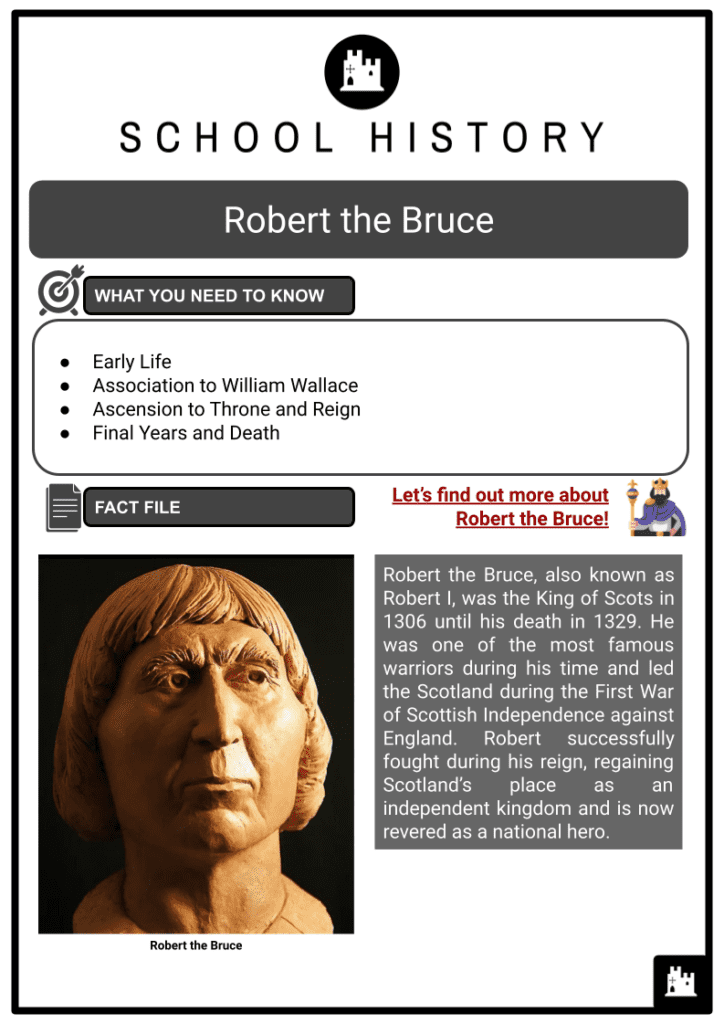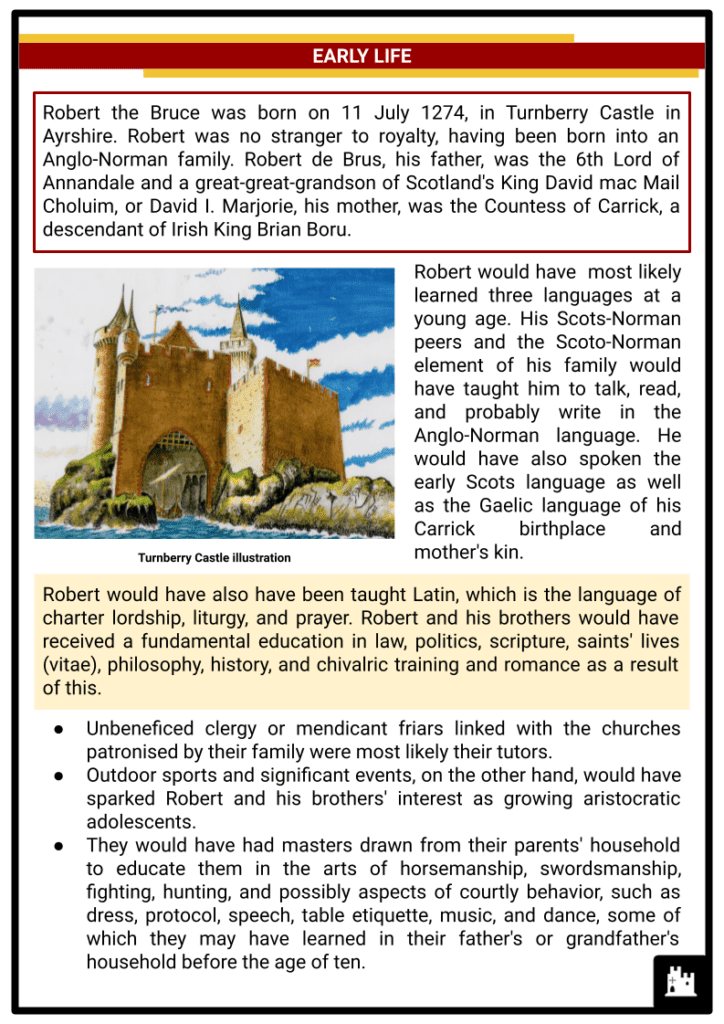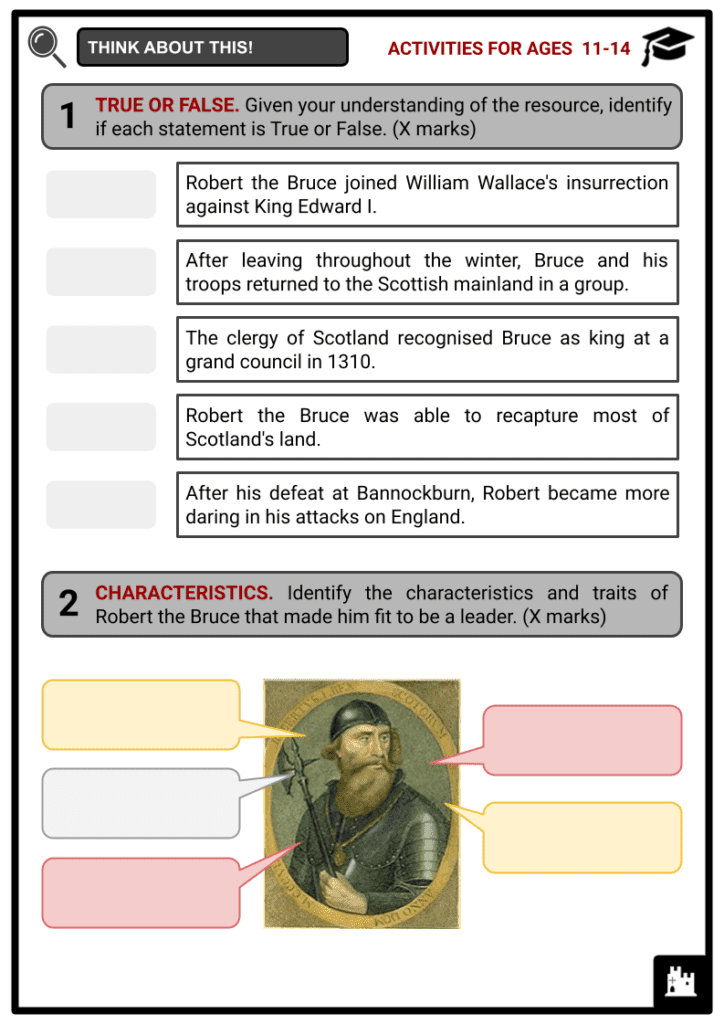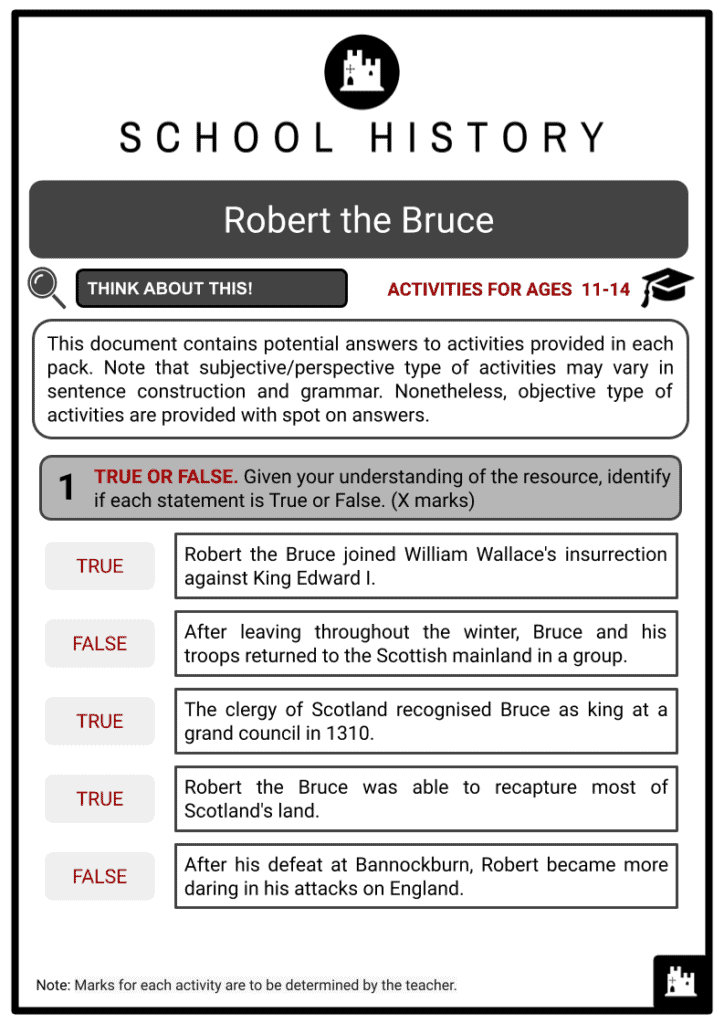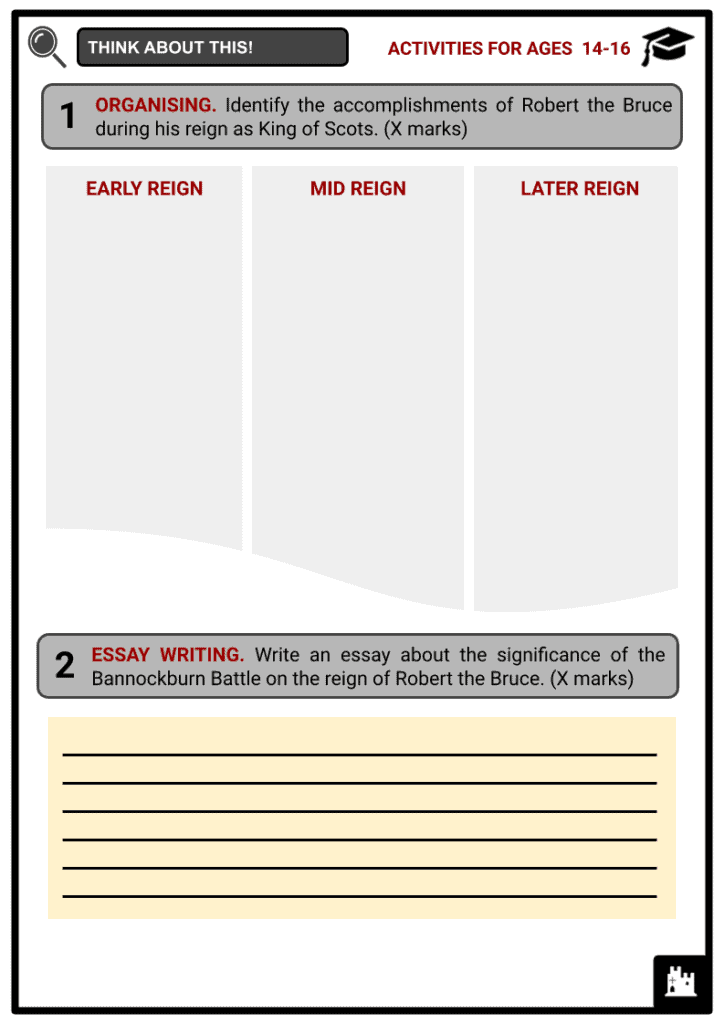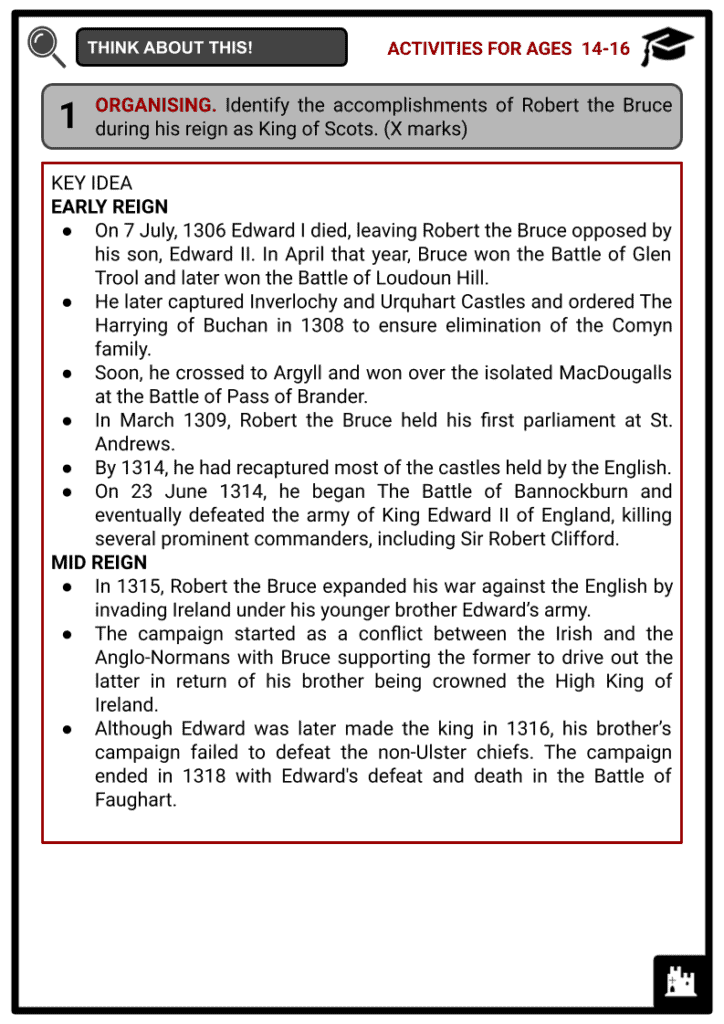Download Robert the Bruce Worksheets
Do you want to save dozens of hours in time? Get your evenings and weekends back? Be able to teach about Robert the Bruce to your students?
Our worksheet bundle includes a fact file and printable worksheets and student activities. Perfect for both the classroom and homeschooling!
Table of Contents
Add a header to begin generating the table of contents
Summary
- Early Life
- Association to William Wallace
- Ascension to Throne and Reign
- Final Years and Death
Key Facts And Information
Let’s know more about Robert the Bruce!
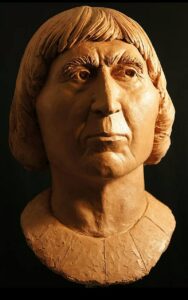
- Robert the Bruce, also known as Robert I, was the King of Scots in 1306 until his death in 1329. He was one of the most famous warriors during his time and led the Scotland during the First War of Scottish Independence against England. Robert successfully fought during his reign, regaining Scotland’s place as an independent kingdom and is now revered as a national hero.
EARLY LIFE
- Robert the Bruce was born on 11 July 1274, in Turnberry Castle in Ayrshire. Robert was no stranger to royalty, having been born into an Anglo-Norman family. Robert de Brus, his father, was the 6th Lord of Annandale and a great-great-grandson of Scotland's King David mac Mail Choluim, or David I. Marjorie, his mother, was the Countess of Carrick, a descendant of Irish King Brian Boru.
- Robert would have most likely learned three languages at a young age. His Scots-Norman peers and the Scoto-Norman element of his family would have taught him to talk, read, and probably write in the Anglo-Norman language. He would have also spoken the early Scots language as well as the Gaelic language of his Carrick birthplace and mother's kin.
- Robert would have also have been taught Latin, which is the language of charter lordship, liturgy, and prayer. Robert and his brothers would have received a fundamental education in law, politics, scripture, saints' lives (vitae), philosophy, history, and chivalric training and romance as a result of this.
- Unbeneficed clergy or mendicant friars linked with the churches patronised by their family were most likely their tutors.
- Outdoor sports and significant events, on the other hand, would have sparked Robert and his brothers' interest as growing aristocratic adolescents.
- They would have had masters drawn from their parents' household to educate them in the arts of horsemanship, swordsmanship, fighting, hunting, and possibly aspects of courtly behavior, such as dress, protocol, speech, table etiquette, music, and dance, some of which they may have learned in their father's or grandfather's household before the age of ten.
- It is also possible that when Robert and Edward Bruce reached the male age of consent of twelve and began training for full knighthood, they were sent to live for a period with one or more allied English royal families, such as the de Clares of Gloucester, or perhaps even in the English royal household.
- On a witness list to a charter given by Alexander Og MacDonald, Lord of Islay, Robert makes his first appearance in history. The Bishop of Argyll, the vicar of Arran, a Kintyre clerk, his father, and a slew of Gaelic notaries from Carrick all appear beside his name. Margaret, Maid of Norway, died in 1290 when Robert Bruce, the future king, was sixteen years old. Robert would have been knighted about this time, and he would have begun to emerge on the political scene in the Bruce dynastic interest.
ASSOCIATION TO WILLIAM WALLACE
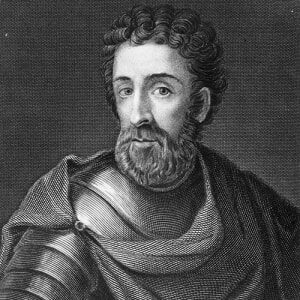
- King Edward I of England was known as the "Hammer of the Scots" because he worked hard to transform Scotland into a feudal tributary state throughout his reign. Naturally, this infuriated the Scots, and Edward quickly found himself dealing with uprisings and rebellions. Robert joined William Wallace's insurrection against Edward, thinking that Scotland ought to stay independent of England.
- A frontal attack on the Bruces was almost the first strike of the Scottish-English conflict.
- Seven Scottish earls made a surprise attack on the walled city of Carlisle on Easter Monday, 1296, which was not so much an attack against England as the Comyn Earl of Buchan and his faction attacking their Bruce enemies.
- Both his father and grandfather were Governors of the Castle at a point of time, and it was their principal residence following the loss of Annandale to Comyn in 1295.
- Robert Bruce would have learned about the city's defenses firsthand.
- Robert the Bruce would lead the attack on Carlisle the following time it was besieged, in 1315.
- The Bruce's properties were excluded from the Lordships and estates that King Edward granted to his adherents after his victory at the Battle of Falkirk. The reason for this is uncertain, though Fordun records Robert fighting for Edward, at Falkirk, under the command of Antony Bek, Bishop of Durham, Annandale and Carrick. This participation is disputed because no Bruce appears on the Falkirk roll of nobles present in the English army, and two 19th century antiquarians, Alexander Murison and George Chalmers, claim Bruce did not participate and instead decided to burn Annandale and Ayr Castle the following month to prevent the English garrisoning it.
- Following his defeat at the Battle of Falkirk, William Wallace resigned as Guardian of Scotland. As joint Guardians, Robert Bruce and John Comyn replaced him, but they couldn't get over their personal conflicts. Comyn was Bruce's adversary since he was a nephew and follower of King John, as well as someone with a strong claim to the Scottish throne. In 1299, Bishop William Lamberton of St. Andrews was chosen as a third, impartial Guardian to try to keep Bruce and Comyn in check.
- Bruce ultimately resigned as joint Guardian the following year, and was succeeded by Sir Gilbert de Umfraville, Earl of Angus. Sir John de Soules took over as single Guardian in May 1301, when Umfraville, Comyn, and Lamberton quit as joint Guardians. Soules was chosen mostly because he was a patriot who did not belong to either the Bruce or the Comyn factions. He was an active Guardian who doubled his efforts to restore King John to the throne of Scotland.
ASCENSION TO THRONE AND REIGN
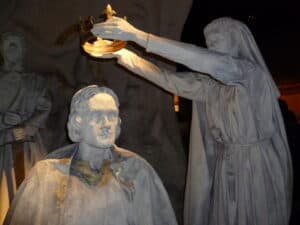
- Early in 1306, two significant events occurred that would affect Scotland's history. Things between John Comyn and Robert reached a climax in February. Robert fatally stabbed Comyn at a church in Dumfries after an argument. When King Edward learned of Comyn's murder, he was furious; Comyn was distantly connected to the king, and Edward interpreted this as a planned conspiracy to incite opposition. For his own protection, Comyn's son, John IV, was hurried away to England and placed in the care of a nobleman who was rearing Edward's own children.
- Robert's father, the 6th Earl of Annandale, died just a few weeks later, in early March. With his father dead and Comyn out of the picture, Robert was the leading contender for the Scottish crown. He rushed quickly to seize control. On 25 March, Robert was crowned king, but an onslaught by Edward's troops drove him out of the country.
- After leaving throughout the winter, Bruce and his troops returned to the Scottish mainland in two groups in February 1307. One of them, headed by Bruce and his brother Edward, landed at Turnberry Castle and launched a guerilla campaign in south-west Scotland. The second group, headed by his brothers Thomas and Alexander, landed in Loch Ryan a little farther south, but they were quickly apprehended and killed.
- In April, Bruce defeated Aymer de Valence, 2nd Earl of Pembroke, at the Battle of Glen Trool, before defeating him at the Battle of Loudoun Hill.
- At the same time, James Douglas attacked and burned his own fortress in Douglasdale, making his first excursion into south-western Scotland for Bruce.
- Bruce went north, leaving his brother Edward in charge of Galloway, taking Inverlochy and Urquhart Castles, destroying Inverness Castle and Nairn, and attacking Elgin unsuccessfully.
- King Edward I died on 7 July 1307, leaving Bruce in opposition to the king's son, Edward II.
- Bruce held his first parliament at St. Andrews in March 1309, and by August he had control of all of Scotland north of the Tay. The clergy of Scotland recognised Bruce as king at a grand council the following year. Despite his expulsion, the church's backing was crucial from a political standpoint. In a failed attempt to promote peace between Scotland and England, Bruce wrote Edward II of England from Kildrum in Cumbernauld Parish on 1 October 1310.
- Over the following three years, Bruce himself seized and reduced one English-held stronghold or garrison after another: Linlithgow in 1310, Dumbarton in 1311, and Perth in January 1312. Bruce also raided northern England, landing at Ramsey on the Isle of Man and laying siege to Castle Rushen in Castletown, which he captured on 21 June 1313, depriving the English of the island's strategic importance.
- Robert continued to battle the English for the following several years, and was able to recapture most of Scotland's land. In the summer of 1314, at Bannockburn, he achieved perhaps his most famous victory. Robert's younger brother Edward had besieged Stirling Castle that spring, and King Edward II felt it was time to proceed north and reclaim Stirling. Hearing of these preparations, Robert gathered his force and went over the marshy territory surrounding Bannockburn, hoping to prevent English troops from regaining Stirling.
- With an estimated five to ten thousand troops contrasted against an English force more than twice that size, the Scottish army was vastly outmanned. Despite their superior numbers, the English were unprepared for any Scottish opposition, and they were caught completely off guard in the marsh's narrow, low-lying region when Robert's spearmen attacked from a forested slope. The cavalry was quickly killed by English archers in the back of the marching column, and the army fled. King Edward is supposed to have narrowly averted death.
- After his triumph at Bannockburn, Robert became more daring in his attacks on England.
- He was no longer willing to only protect Scotland, and he led forays into northern England's border territories, as well as into Yorkshire.
- At the invitation of Donall O'Neill, king of Tyrone, one of Gaelic Ireland's eastern kingdoms, he battled English forces in Ireland in 1315.
- Robert's younger brother Edward was proclaimed High King of Ireland a year later, momentarily strengthening the Irish-Scottish tie.
- For several years, Robert sought to forge an alliance between the two kingdoms, but it fell apart when the Irish perceived Scottish occupation as no different from English occupation.
FINAL YEARS AND DEATH
- Robert thought in 1320 that diplomacy, rather than armed action, would be a better way to achieve Scottish independence. The Declaration of Arbroath was addressed to Pope John XXII, and it stated all of the reasons why Scotland should be regarded an independent nation. It eventually served as the model for America's Declaration of Independence. The proclamation not only detailed King Edward II's atrocities against the people of Scotland, but it also said that while Robert the Bruce had spared the kingdom from English control, the aristocracy would not hesitate to replace him if he became unfit to reign.

